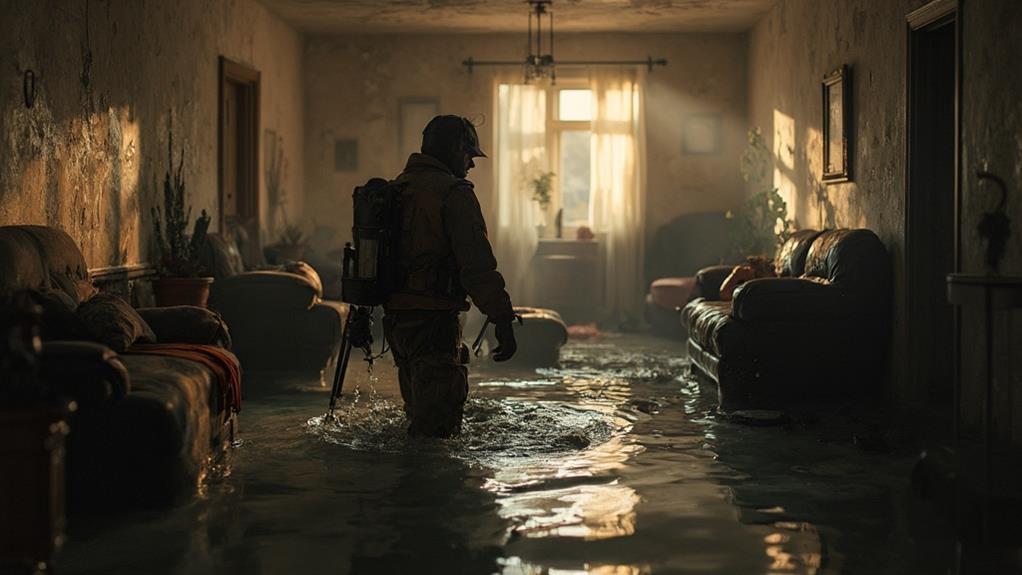When discovering standing water indoors, prioritize personal safety first. Assess the risk of electrocution and structural damage before entering the area. Identify and stop the water source immediately. Document the damage with photos and videos for insurance purposes. Remove standing water using appropriate methods, such as wet vacuums or pumps. Contact your insurance company promptly to report the incident. Begin the drying process by deploying fans and dehumidifiers. Take steps to prevent mold growth by thoroughly cleaning and disinfecting affected areas. Quick action is crucial to minimize damage and health risks. Understanding the full scope of necessary actions can significantly improve your emergency response.
Ensure Personal Safety First
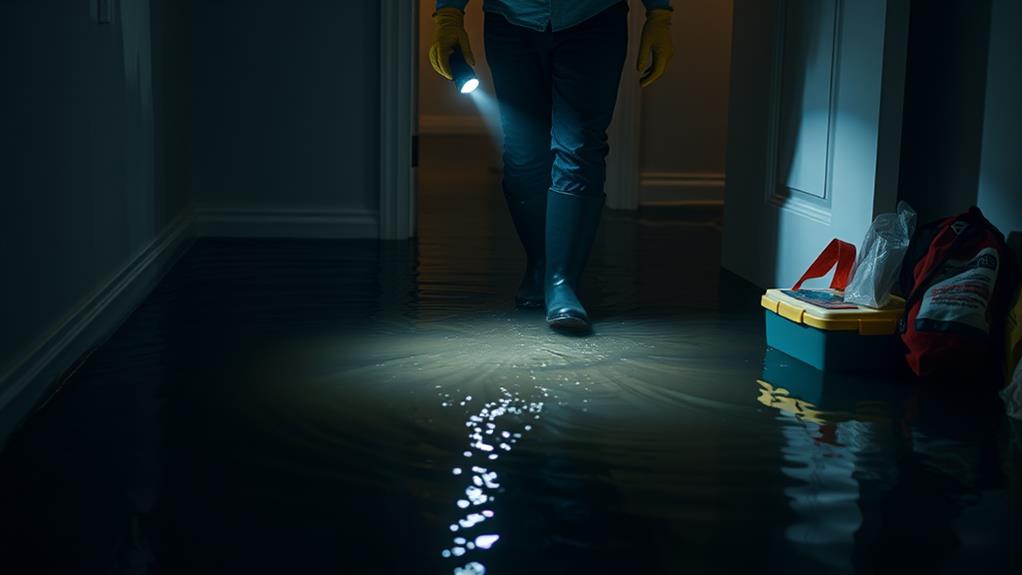
The paramount concern when encountering standing water indoors is personal safety. Before taking any action, assess the situation carefully. If the water level is above electrical outlets or if you suspect electrical appliances are submerged, do not enter the area. Water can conduct electricity, posing a severe risk of electrocution. Instead, immediately shut off the main power supply if it's safe to do so.
Be aware of potential structural damage. Standing water can weaken floors, walls, and ceilings, creating hazardous conditions. Look for signs of sagging or buckling surfaces before entering the affected area. If you notice any structural instability, evacuate the premises and contact professionals.
Check for contamination. Standing water may contain sewage, chemicals, or other harmful substances. Wear appropriate protective gear, including waterproof boots, gloves, and eye protection, before approaching the water. If you suspect hazardous materials are present, leave the area and contact emergency services.
Ensure proper ventilation to prevent mold growth and the accumulation of harmful gases. Open windows and doors if weather permits, and use fans to circulate air. If you smell gas or suspect a gas leak, evacuate immediately and contact your gas company or emergency services.
Identify and Stop Water Source
After ensuring personal safety, the next critical step is to identify and stop the source of the water. This process requires a systematic approach to determine the origin of the standing water. Common sources include burst pipes, malfunctioning appliances, roof leaks, or external flooding.
Begin by visually inspecting the affected area and adjacent rooms for signs of water ingress. Listen for running water or unusual sounds that might indicate a leak. Check water-using appliances such as washing machines, dishwashers, and water heaters for malfunctions. Examine visible plumbing fixtures and pipes for damage or leaks.
If the source is a burst pipe or malfunctioning appliance, immediately shut off the main water supply to the building. For appliance-related issues, unplug the device if it's safe to do so. In cases of roof leaks, use buckets to collect water and cover the affected area with waterproof material if possible.
For flooding from external sources, such as heavy rain or overflowing bodies of water, focus on preventing further water entry by sealing openings and using sandbags or flood barriers. Contact local authorities for assistance with large-scale flooding events.
Document the Damage
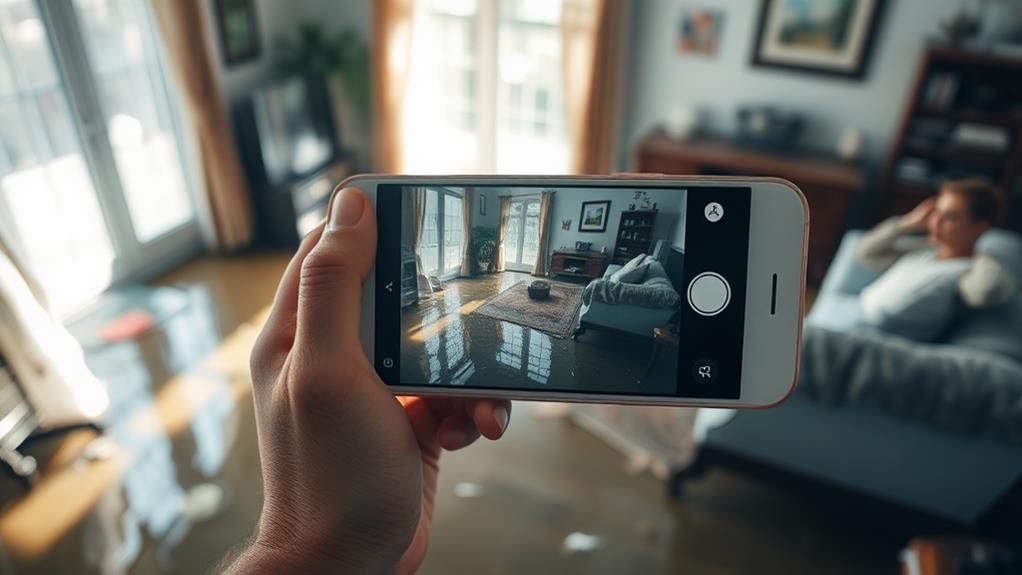
Documenting the damage is a crucial step in the aftermath of indoor water intrusion. This process serves multiple purposes, including supporting insurance claims, guiding restoration efforts, and creating a historical record of the incident. Begin by taking detailed photographs and videos of all affected areas, ensuring to capture both wide shots and close-ups of specific damage points. Pay particular attention to water-logged materials, structural impacts, and any visible mold growth.
Create a comprehensive inventory list of damaged items, including furniture, electronics, personal belongings, and structural elements. Note the approximate age, condition, and estimated value of each item. If possible, locate and compile relevant receipts or proof of purchase for high-value items. Measure and record the extent of water penetration, including the depth of standing water and the height of water stains on walls. Document any unusual odors, as these can indicate hidden damage or potential health hazards.
Keep a detailed log of all actions taken, including initial discovery, water removal efforts, and any temporary repairs. This documentation will prove invaluable when dealing with insurance adjusters and restoration professionals, ensuring a smoother recovery process.
Remove Standing Water
Swift action is essential when removing standing water from indoor spaces. The longer water remains, the more damage it can cause and the higher the risk of mold growth.
Begin by ensuring the area is safe to enter, checking for electrical hazards or structural damage. If possible, identify and stop the water source to prevent further flooding.
For small amounts of water, use towels, mops, or a wet vacuum to absorb the liquid. For larger volumes, employ a submersible pump or a heavy-duty water extractor. Start from the edges and work towards the center of the affected area. Pay special attention to corners and hard-to-reach spaces where water may accumulate.
If dealing with contaminated water, such as sewage backups, wear appropriate personal protective equipment, including waterproof boots, gloves, and goggles. Disinfect all surfaces that came into contact with contaminated water.
After removing visible water, use fans and dehumidifiers to accelerate drying. Open windows and doors to improve air circulation, if weather permits. Monitor humidity levels and continue drying efforts until the area is completely dry to prevent secondary water damage and mold growth.
Contact Insurance Company
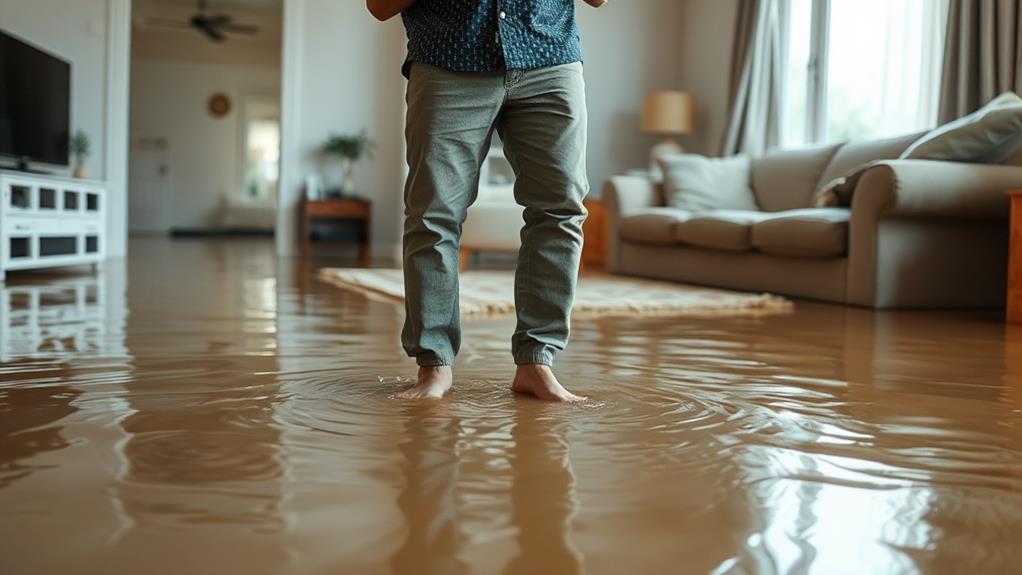
Once the immediate water removal process is underway, contacting your insurance company should be a top priority. Promptly informing your insurer about the water damage incident can expedite the claims process and ensure you receive proper guidance on next steps. Have your policy number ready and document the damage thoroughly with photos and videos before any cleanup begins.
When speaking with your insurance representative, inquire about coverage for water damage, including any limitations or exclusions in your policy. Ask about the process for filing a claim and whether an adjuster will be sent to assess the damage. Be prepared to provide detailed information about the cause of the water intrusion, the extent of the damage, and any emergency measures you've taken.
Discuss whether your policy covers temporary relocation expenses if your home becomes uninhabitable. Request clarity on the timeline for processing your claim and any documentation requirements. Keep detailed records of all communications with your insurance company, including dates, times, and names of representatives you speak with. This information will be crucial if any disputes arise during the claims process.
Begin Drying Process
After addressing immediate safety concerns and contacting your insurance company, initiating the drying process is crucial to mitigate further damage. Begin by removing as much standing water as possible using pumps, wet vacuums, or even buckets and mops for smaller areas.
Once the bulk of the water is removed, focus on thorough air circulation to accelerate evaporation. Open all windows and doors to allow fresh air to flow through the affected area. Deploy high-powered fans strategically to create cross-ventilation and direct airflow over wet surfaces. Dehumidifiers are essential in reducing moisture levels in the air, preventing secondary water damage and inhibiting mold growth. Place them in the center of the room for maximum efficiency.
Remove wet carpets, rugs, and padding, as these items retain moisture and impede the drying process. Lift and prop up furniture to allow air circulation underneath. Dispose of saturated materials that cannot be salvaged, such as drywall or insulation. For valuable items or those with sentimental value, consider professional restoration services. Throughout the drying process, monitor humidity levels and continue running equipment until the area is completely dry, which may take several days.
Prevent Mold Growth
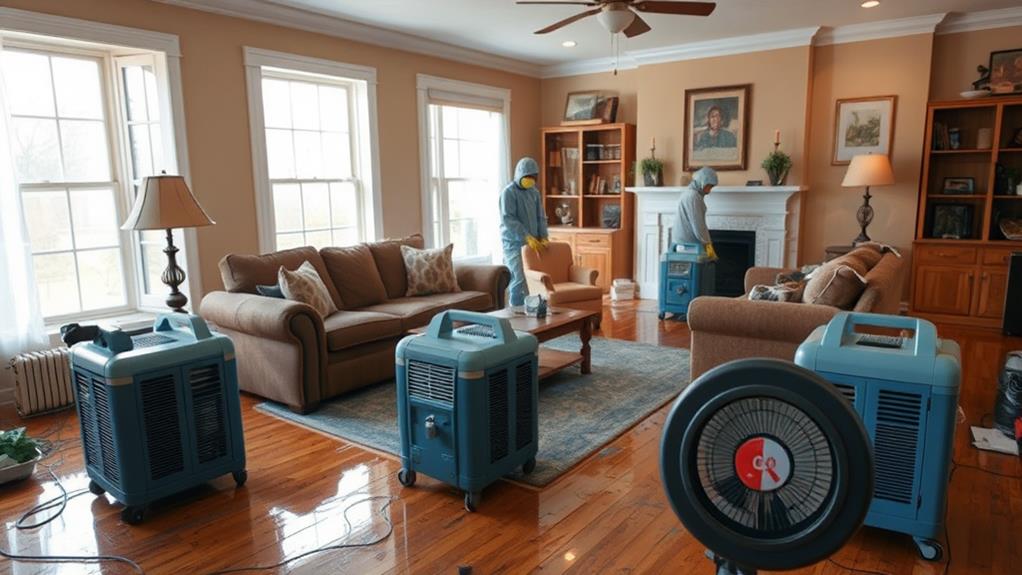
While drying the affected area is a key step, preventing mold growth is equally important in the aftermath of indoor flooding. Mold can begin to develop within 24-48 hours of water exposure, posing significant health risks and causing further property damage. To mitigate this threat, act swiftly and thoroughly.
First, remove all wet materials, including carpets, furniture, and drywall, as these provide ideal conditions for mold growth. Clean and disinfect all surfaces with a solution of one cup of bleach per gallon of water. Pay special attention to porous materials, which are more susceptible to mold infestation.
Maintain good air circulation by opening windows and using fans to promote drying. Dehumidifiers can help reduce moisture levels, creating an environment less conducive to mold growth. Monitor humidity levels and aim to keep them below 50%.
Inspect hidden areas such as crawl spaces, attics, and behind walls for signs of moisture or mold. Address any leaks or water ingress points to prevent future issues. If mold growth is extensive or you're dealing with sewage contamination, consider hiring professional remediation services to ensure thorough and safe cleanup.
Frequently Asked Questions
How Long Does It Take for Water Damage to Become Irreversible?
The timeline for irreversible water damage varies depending on factors such as material type and moisture levels. Generally, mold can start growing within 24-48 hours, and structural damage can occur within days if not addressed promptly.
Can I Use a Regular Vacuum Cleaner to Remove Standing Water?
Like a fish out of water, using a regular vacuum cleaner for standing water is ill-advised. It's not designed for liquids and can be dangerous. Instead, use a wet/dry vacuum or professional water extraction equipment for safe and effective removal.
What Items Are Most Susceptible to Water Damage and Should Be Prioritized?
Electronics, documents, photographs, and wooden furniture are highly susceptible to water damage. Prioritize these items for immediate removal or protection. Upholstered furniture, carpets, and personal belongings should also be addressed promptly to minimize potential damage and mold growth.
How Can I Tell if Water Has Seeped Into My Walls?
Like a hidden tide, water damage in walls can be elusive. Look for telltale signs: discoloration, peeling paint, warping, or bubbling wallpaper. Touch walls for dampness, and use a moisture meter for accurate detection. Musty odors also indicate potential issues.
Are There Any Health Risks Associated With Exposure to Standing Water Indoors?
Exposure to standing water indoors poses significant health risks. These include bacterial and viral infections, mold growth, and exposure to harmful contaminants. Prolonged contact may lead to respiratory issues, skin infections, and other serious health problems.
Conclusion
Swift action is crucial when dealing with indoor standing water to minimize damage and prevent health hazards. Following a systematic approach of safety, water removal, documentation, and drying can significantly mitigate long-term consequences. Interestingly, according to the Insurance Information Institute, water damage and freezing account for 23.8% of all homeowners insurance claims, emphasizing the prevalence of this issue. Proper knowledge and preparation for water emergencies can save both property and financial resources in the long run.
